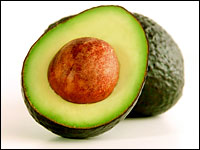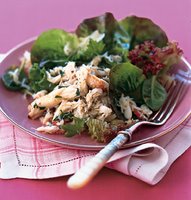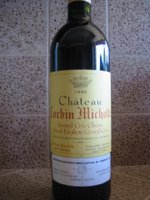Sunday, July 30, 2006
Saturday, July 29, 2006
Having a kid's gonna be sweet
Henceforth, our lives will be singularly devoted to making little Jimmy/Jenny the best. Only the limitations of our feeble bodies will bound the love, devotion and adoration we shower on this child. Unless of course he/she turns out to be a total dork or, worse, a vegetarian. In that case, the child will receive ridicule and scorn.
But seriously, we're really looking forward to getting some help around the house. In a few years, we figure we won't have to do ANYTHING.... the kids will cook dinner, mow the lawn, go to work, etc. It's going to be awesome. I bet I could even make them wash your car or something, so come over if you need something done.
Friday, July 28, 2006
Unintended Irony
 The Guardian reports on a somewhat controversial photo exhibit by Photographer Jill Greenberg. Ms. Greenberg took lollipops from her young models and then photographed their distressed faces. Not surprisingly, some people felt this was inappropriate.
The Guardian reports on a somewhat controversial photo exhibit by Photographer Jill Greenberg. Ms. Greenberg took lollipops from her young models and then photographed their distressed faces. Not surprisingly, some people felt this was inappropriate.The photos evidently convey the artist’s frustration with the Bush Administration. My buddy Dog comments:
Apparently lost on this ‘intellectual’ artist is the irony involved with comparing your views on politics to a blubbering baby.
The artist is trying to depict her feelings, not her views. Nonetheless, his comment cracks me up. (Photo: Jill Greenberg)
Monday, July 24, 2006
"I will do what I do"
 Last Thursday, the Wizards signed 6-foot-8 Lithuanian forward Darius Songaila to a 5-year, $23MM contract. The 4th-year player spent two seasons in Sacramento working with Pete Carril, the inventor of the Princeton offense the Wizards use. This WaTimes report quotes Darius thusly:
Last Thursday, the Wizards signed 6-foot-8 Lithuanian forward Darius Songaila to a 5-year, $23MM contract. The 4th-year player spent two seasons in Sacramento working with Pete Carril, the inventor of the Princeton offense the Wizards use. This WaTimes report quotes Darius thusly:I like to come out and play the elbow game," Songaila said. "I can take a big man outside and go around him. This team is good for me because it has players like Gilbert and Antawn Jamison. You won't see me doing a lot of crazy dunks but I will do what I do. I'll be an outside threat and I'll do some passing, play good defense.
I imagine Songaila delivering this quote with an ice cold stare and thick accent ala Captain Ivan Drago (Dolph Lundgren) in Rocky IV. I really like the "…I will do what I will do" part. He could mean shooting/passing/picking from the top of the key, or he could mean slicing opposing players’ Achilles tendons with razor tipped shoes, kidnapping their children, etc. Either way, he'll improve the Wizards.
Friday, July 21, 2006
Wednesday, July 19, 2006
From ahuacate to avocado
 Howard Yoon tells the story of U.S. avocado production and consumption in this NPR piece. Interestingly, the term avocado was created by enterprising US farmers who considered the Aztec name, ahuacate, too hard to pronounce and rather unappetizing (it translates to testicle). Check out the full story.
Howard Yoon tells the story of U.S. avocado production and consumption in this NPR piece. Interestingly, the term avocado was created by enterprising US farmers who considered the Aztec name, ahuacate, too hard to pronounce and rather unappetizing (it translates to testicle). Check out the full story.
Tuesday, July 18, 2006
Friday, July 14, 2006
Status, image and customer satisfaction
- According to research by Chistian Barrere, Veronique Chossat and Florine Livat, prices for Parisian meals defined by the Michelin guide as "very comfortable" to "luxury" rose 217% in real terms, while nonluxury food became cheaper during that period.
- Researchers Olivier Gergaud and Vincenzo Verardi created a value index of Parisian food, which compares price with customer satisfaction as measured by the Parisian Zagat Survey. Many prestigious restaurants faired badly.
- Research by Sebastian Lecocq and Michael Visser finds that wine consumers pay similar premiums for status and prestige. Their study of Bordeaux and Burgundy vintages found that prices reflect professional ratings and label information more than customer satisfaction (as measured by subjective taste tests).
These studies seem to show that expert opinion correlates with price more than consumer opinion. This probably means that, from a taste perspective, it doesn't sense for an average guy like myself to stock up on Chateau Mouton-Rothschild. But if you happen to have "expert" taste buds, it may be worth it to spend the extra money. Alternatively, some people undoubtedly go to fancy restaurants and by expensive wines precisely for the prestige and image.
By the way, the wine research appeared in the brand spankin’ new Journal of Wine Economics. Cool, an entire journal devoted to the allocation of scarce wine resources (hopefully bearing in mind that "There ain’t no such thing as a free lunch")!
Tuesday, July 11, 2006
Intellectual property rights and food
I’m assuming there is no legal framework in which to do this. Otherwise, wouldn’t there be disclaimers on cookbooks warning that use of the enclosed recipes is exclusively for your non-profit use? Wouldn’t I have heard about restaurants paying royalties to famous chefs across the world?
If there is no copyright system for food, why isn't there? Why aren't intellectual property rights for food protected, whilst those for music, literature and film are? Would a system of food copyrights increase or decrease culinary innovation?
Online wine buying guide
Since shipping charges can add considerable cost to online wine purchases, I only shop online when I can’t find something locally (consistent with Mr. Bainbridge’s advice I suppose). I’ve had good experiences with both wine.com
Monday, July 10, 2006
Price is the ultimate tool of conservation
Paraphrasing Lynne, the current goals are regulated retail prices, no new transmission lines, no new generation, and no blackouts. Assuming continued growth in electricity demand though, the best publicly run electric system can only achieve 3 of the 4 goals in the long run.
As demand increases, you need to A) allow dynamic pricing mechanisms to properly allocate scare energy resources, or B) build more power plants in the region, or C) build transmission to bring power from another region, or D) suffer blackouts.
California is a great example. Grid management options A through C were basically off the table, which eventually led to the selection of option D by default. Indeed, NIMBY politics makes it very difficult to exercise options B and C.
Of course, by far the most efficient solution is option A with occasional use of options B and C.
[Ed: What about conservation?] Yes, conservation efforts do play a role. But generally conservation efforts are not sufficient to mitigate demand increases. This is because regulated price schemes destroy the best conservation incentive; market-based price signals.
For example, prolonged heat waves can put a lot of pressure on the northeastern power grid. Why? Because millions of homes, offices, school’s etc. crank of their electricity hogging’ air conditioners.
But if most consumers faced variable, market based prices for energy, you can bet they’d take energy conservation more seriously. For during that heat wave, electric prices would increase (reflecting increases in energy demand). As a result of these higher prices, some consumers would take mitigating action. Perhaps they’d set the thermostat to 78 degrees instead of 72 degrees, or maybe they’d invest in better roof insulation. These actions would serve to lessen the increase in demand, thereby protecting the integrity of the grid.
In this way, price is the ultimate tool of conservation.
Friday, July 07, 2006
The Rodney Dangerfield of the wine world?
 I'd love to have dinner with Fred Franzia at French Laundry. I imagine it'd be just like hanging out with Al Czervik at the Bushwood Country Club.
I'd love to have dinner with Fred Franzia at French Laundry. I imagine it'd be just like hanging out with Al Czervik at the Bushwood Country Club.Vinography has the story.
Thursday, July 06, 2006
All wine is manipulated
You see, planting vines in neat little rows is manipulation. Growing them in the desert using drip irrigation is manipulation. Picking and crushing grapes is manipulation. The use of oak is manipulation. Indeed, the wine making process is but a series of manipulations.
So please, let’s avoid using meaningless terms like "manipulated wine". For example, let’s stop arbitrarily classifying oak barrel maturation as natural, while considering the use of oak chips a manipulation. It’s all unnatural manipulation, darn it!
This is not to say one shouldn’t favor certain winemaking practices over others. For example, stand up and be heard if you only drink biodynamic wine, but don’t support your view with vaugeries. Rather, give some specific reasons why you like biodynamic wine.
Taste is a great rationale. But wine is more than just a sensory experience, so tradition and or culture might be good reasons too. Or maybe you believe biodynamic wine is produced in a more environmentally friendly manor. Or perhaps you feel biodynamic wine puts you in touch with Mother Earth. It doesn’t really matter, just know why you think what you think (and try to be intellectually consistent).
Whatever your reasons, keep in mind that taste and preference are subjective. For example, I’ll fully support your right to believe wine is best produced and consumed in terra cotta pots. But please, don’t start acting as though you are drinking wine the "right" way, while the rest of us poor idiots are drinking the "wrong" way. Remember, you don’t have the moral high ground and you’re not "right" in an objective sense.
Addendum: Vinography’s got a great article noting that many wines are not produced in accordance with some wine lover’s romantic standards. Said one commentor, "Perhaps [some wine lovers have] been drinking a fairy tale, passionately arguing in support of a perspective on wine that scarcely exists in the real world…"
Economic knowledge, economic interest and gender
Kaplan suspects the knowledge gap results becuase men, due to their greater interest in Economics, are much more likely to study economics than women. The more schooling one has, the greater the time to study more econ, and thus the greater the gap.
Why are men more interested in economics? Kaplan doesn't venture a guess, though he offers some suggestions. Check out the paper here.
Wednesday, July 05, 2006
WBW #23 - 2003 Château La Vernède Coteaux du Languedoc
To me, the Fourth of July means grilled (as opposed to barbequed) red meat, especially burgers. A good Independence Day wine should a) be able to cut through rich, greasy meat, b) be easy to drink and accessible, c) complement typical grilled meat flavors (smoke, spice, pepper), and d) be reasonably priced.
I decided to go with the 2003 Chateau La Vernède Coteaux du Languedoc. Firm tannins enable this blend of Syrah, Grenache, Mourvedre and Carignan to cut through red meat. This smoky wine’s sweet, dark fruit flavors complement grilled foods and are easy to enjoy. And the price is right at only $6.99.
Writing tasting notes is really hard. The above description could accurately describe hundreds of wines that really don’t taste all that much alike. I like to taste several wines at the same time, for I find that side by side comparison helps me to better understand what I'm drinking (and to enjoy a lot more of it, of course).
For comparison’s sake then, I drank the 2004 Fess Parker Frontier Red Lot #41, a blend of Syrah, Grenache, Petite Sirah, Mourvedre, Cinsault and Carignan. This soft, round, medium-bodied wine tastes like Fess Parker started with the La Vernede, but then turned the style knob to obnoxious. It’s so absurdly rich and savory, it’s as if some kind of mocha fudge flavoring was added. What food would I like with this wine? What food could I even taste with this wine?
I hope my description of the Frontier Red isn’t coming across as too harsh. If you want your wine to be a meal in itself, then Fess Parker’s Frontier Red is for you. Lot's of folks (including Robert Parker) like this wine. But I prefer something a little more food friendly. I'll take the La Vernede.
2003 Château La Vernède Coteaux du Languedoc, $6.99 from Esquin Wine Merchants.
2004 Fess Parker Frontier Red Lot #41, $8.45 from Pete’s Wine Bellevue.
UPDATE: Joel Vincent's excellent round up of WBW#23 is here. Check it out for some great recipes and great wine.
Also, here's the recipe for my 4th of July burgers (actually, this is my old buddy Randy's recipe):
Mix 3 parts ground beef (not more than 80% lean) with 1 part ground, spicy breakfast sausage. Add salt, pepper, Italian seasoning, paprika, cayenne, fresh minced garlic, fresh minced onion (white or red), and your favorite barbecue sauce to taste. Don’t be bashful with the seasonings, esp. the bbq sauce and the onions. Form the mix into patties (the meat will bind better if you add an egg or two). Store in fridge, preferably overnight. Bring burgers near room temperature and grill to desired doneness.
2005 Horton Viognier, Orange County
 Virginia wine pioneer Dennis Horton has been experimenting with grapes in the state for nearly 30 years. After mostly unsuccessful attempts with the big Bordeaux and Burgundian varietals, he moved to Rhone varietals and, more recently, to Iberian varietals. He also grows Norton, a Virginia native widely cultivated in his home state of Missouri.
Virginia wine pioneer Dennis Horton has been experimenting with grapes in the state for nearly 30 years. After mostly unsuccessful attempts with the big Bordeaux and Burgundian varietals, he moved to Rhone varietals and, more recently, to Iberian varietals. He also grows Norton, a Virginia native widely cultivated in his home state of Missouri.Horton planted Viognier after a visit to the Rhone Valley, believing the warm weather loving, somewhat frost and mildew resistant varietal would be a perfect match for Virginia’s climate; hot and humid summers that often follow late spring frosts. He was right.
In the late 1990’s, Decanter Magazine wrote, "Horton is probably making the USA's finest Viognier." A WaPost article quotes an oenologist's assertion that, "[Horton’s]… 1993 Viognier is considered by many to be the finest Viognier ever produced in this country", and notes its inclusion in Paul Lukac’s new book The Great Wines of America. Clearly, Denis Horton’s Viognier has been well received.
I wanted to try this wine because it’s from my home state of Virginia and because I’d read Horton makes his Viognier more in the French style than the California style. That is, his wines supposedly emphasize crisp acidity rather than big, fat fruit. Sounds like my kind of wine. My wife graciously bought a bottle of the stuff on her recent visit to DC/Virginia and hauled it back to the Emerald City for me.
With all the hype, I was frankly preparing myself to be disappointed. I was not disappointed. This wine gives you peach and vanilla and some overt residual sugar. The Horton Viognier would be too sweet for my taste, were it not deftly balanced by tongue tickling acidity. The acidity creates a sensation that reminds me of Moscato d’Asti’s effervescence. This is a really enjoyable, food friendly wine that will please a wide range of palates. Good stuff. E.F. Glutton and I were most impressed.
$12.99 from Total Wine & More.
Addendum: My bottle was labeled "The Tower Series". According to Horton Vineyards, this is identical to the wine sold at the vineyard tasting room and other wine shops for $20. The Tower Series Viognier has a black label with a gold drawing of the Horton winery, whereas other bottlings feature the traditional grape clad label shown above. I’d pay $20 for this wine, but at $12.99 I’d buy a case of it. Unfortunately, Total Wine & More does not ship.
Mmmm, shellfish and white wine
 I had E.F. Glutton over for dinner last Wednesday while my wife was out with her girlfriends. It was a good opportunity for me to make some shellfish, since a) my wife is currently avoiding shellfish, and b) I’ve been dying for an excuse to pull out a few white wines that happen to be shellfish friendly.
I had E.F. Glutton over for dinner last Wednesday while my wife was out with her girlfriends. It was a good opportunity for me to make some shellfish, since a) my wife is currently avoiding shellfish, and b) I’ve been dying for an excuse to pull out a few white wines that happen to be shellfish friendly.Lemony crab salad with baby greens paired with the 2005 Horton Viognier started us off. I recommend using less olive oil and including a big, fat lemon wedge garnish, as this salad needed more acidity. Also, it’s worth getting quality crab meat, for if the crab is bland the salad will be bland (unfortunately, I lazily bought crab from my local grocery store instead of the seafood store near my house). The delicious Horton Viognier will get a full post later today. We loved this wine.
Next we enjoyed a small serving of pan-seared scallops with champagne grapes and almonds (the same dish I talked about here). This time I seared the scallops perfectly, but the sauce came out a bit thin. I think one should use medium-high heat for the scallops, but probably only medium heat for the sauce. Still, great flavors.
We finished off the Horton and opened up a bottle of the 2003 Sakonnet Vidal Blanc, Southeastern New England. E.F. Glutton loved this Rhode Island wine a year ago and very thoughtfully picked me up a bottle during a recent trip to Beantown. The 2001 vintage was featured as one of ten All-American wines in Food & Wine Magazine.
E.F. and I were very excited about this wine, but alas we were disappointed. The Sakonnet tasted flat in comparison with the Horton. While it delivered some nice richness, it lacked bright fruit flavors. E.F. wondered if the wine hadn’t passed it’s prime. Don’t get me wrong, this was an enjoyable wine. It unfortunately didn’t meet our high expectations, however. To be fair, it’d have been tough for any wine tasted after the Horton.
Our entrée was a simple and delicious Seafood Catizone. The crushed fennel and basil matched well with the scallops and shrimp. Once again, a lemon wedge garnish amplified the flavors (and seemed to improve the Sakonnet as well). I was pleased with this dish, though next time I’ll try adding a splash of white wine. Epicurios strikes again!
Finally, for dessert we enjoyed some excellent smoked Gouda and the 2004 Josef Leitz Rudesheimer Drachenstein. I feel this wine lacks the acidity needed to balance its conspicuous sweetness. While pleasant as a desert, I probably wouldn’t enjoy it that much in another context. Keep in mind that I tend towards dry, acidic whites. If you like sweet wines, this may be for you. (Photo: Leo Gong/Bon Appetit)
1996 Chateau Corbin Michotte
 This Saint-Emillion Grand Cru Classe is an affordable taste of mature, right bank Bordeaux. Chateau Corbin Michotte is a round and soft blend of Merlot, Cabernet Franc and Cabernet Sauvignon that gives you dark fruit, chocolate, and smoke. I enjoyed it very much with grilled beef tenderloin. Why wait when you can drink a mature wine now?
This Saint-Emillion Grand Cru Classe is an affordable taste of mature, right bank Bordeaux. Chateau Corbin Michotte is a round and soft blend of Merlot, Cabernet Franc and Cabernet Sauvignon that gives you dark fruit, chocolate, and smoke. I enjoyed it very much with grilled beef tenderloin. Why wait when you can drink a mature wine now?$16.99 at Esquin Wine Merchants, imported by Bordeaux Wine Locators, Inc.








